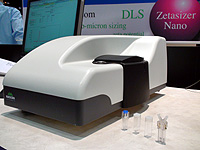Malvern Particle Size Analyser
18 Jun, 2018 What is particle size analysis?is used to characterise the size distribution of particles in a given sample. Particle size analysis can be applied to solid materials, suspensions, emulsions and even aerosols. There are many different methods employed to measure particle size. Some particle sizing methods can be used for a wide range of samples, but some can only be used for specific applications.


It is quite important to select the most suitable method for different samples as different methods can produce quite different results for the same material. Who uses particle size analysis?Particle size analysis is a very important test and is used for quality control in many different industries.
In just about every industry where milling or grinding is used, particle size is a critical factor in determining the efficiency of manufacturing processes and performance of the final product. Some industries and product types where particle sizing is used includes:. Pharmaceuticals. Building materials.
Paints and coatings. Food and beverages. AerosolsEquivalent sphere theoryOne basic problem in particle size analysis is characterizing particles using just one number. Most particle sizing techniques aim report particle size distributions on a two dimensional graph (ie. Particle size on the x-axis and quantity of material on the y-axis). However, the difficulty with this is that there is only one shape that can be described by a single unique number, and that is the sphere. Only a sphere measures the same across every dimension.
If we say we have a 100 micron sphere, this describes it exactly. We cannot say the same for a cube, where the 100 micron may describe the length of one edge, or even a diagonal transect.For this reason, all particle sizing techniques measure a one dimensional property of a particle and relate this to the size of an “equivalent sphere”. One example is to measure the surface area of a particle and then report the size of sphere which has the same surface area. Probably the most common method is to measure the “volume” of each particle in a sample and report the size of a sphere which has the same volume as the particles being measured (this is what is done in Laser Diffraction methods).
Particle Sizing by laser diffractionhas become one of the most commonly used particle sizing methods, especially for particles in the range of 0.5 to 1000 microns. It works on the principle that when a beam of light (a laser) is scattered by a group of particles, the angle of light scattering is inversely proportional to particle size (ie.
Borderlands 2 grenade mods. The smaller the particle size, the larger the angle of light scattering). Laser diffraction has become very popular because it can be applied to many different sample types, including dry powders, suspensions, emulsions and even aerosols. It is also a very fast, reliable and reproducible technique and can measure over a very wide size range. Other methodsThere are many other methods for analysing particle size, other than.
Malvern Particle Size Analyzer Time

Malvern Particle Size Analysis
Sieving is one of the oldest particle sizing methods and is still widely used for relatively large particles (ie. When measuring very small particles (ie.